Uv heating is at the forefront of science
Traditional heating systems are rather inconvenient in operation and have a relatively large inertia, even with the use of materials with high thermal conductivity. Infrared heating from this point of view has a lot of advantages. Despite the prevalence of infrared heaters, many people have little idea of their principle of operation, but after getting acquainted with the proposed material, there should be no questions left.
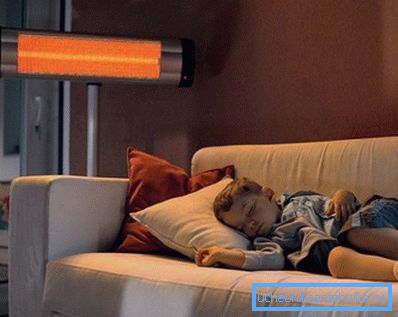
Small educational program
When searching for information on this type of heating a person may encounter the fact that it is called infrared heating, ultraviolet, etc. Most often we are talking about the same thing - infrared heating, and confusion arises because of the banal ignorance of the characteristics of the spectrum of visible radiation.
The fact is that the perception of light by the human eye completely depends on its wavelength. On average, we can say that the visible part of the spectrum is in the range of 380 - 760 nm (the wavelength is indicated). Everything that lies outside this range does not see the eye, but the environmental impact of these rays does not go anywhere.

If the wavelength is less than about 340-380 nm, then the ultra prefix appears, that is, the light lies outside the purple color. Infrared radiation is characterized by a longer wavelength, it is also called thermal radiation.
Infrared radiation is used in the heating of residential and industrial buildings, but ultraviolet is widely used in human activity. UV radiation is used for decontamination, authentication of bank notes and other securities and in many other areas of activity.
Note! Summer tan, we all owe just the same UV rays. Sunburn is a kind of protective reaction of the body.
Advantages of infrared heating
The strengths of this method of heating the room can be counted a lot:
- energy is not spent on heating all the air in the room, and this is what happens when using traditional heating systems. Due to the directional effect of infrared heating, it can create local zones with a comfortable temperature;

Note! The latter is especially important in industry when it is necessary to heat spacious workshops. The infrared heater will simply create a comfort zone exactly where the worker will be most of the time, while the drafts are not terrible;
- the air does not dry, as when using, for example, wind. By and large, it is not the air that is heated, but the surface on which infrared radiation falls;
- The efficiency of the device is about 90% and above;
- as such, the coolant is absent, so that no depressurization of the system is out of the question;
- heating will work absolutely silently;
- You do not need to spend money on pipes, boiler, circulation pump and other elements of a standard heating system; for operation, it is enough to fix the device on a wall or ceiling and plug it into an outlet;
- such heating practically does not differ from natural (that is solar). The fact is that about 50% of the thermal energy from the Sun, the Earth receives in the form of IR heating.
Among the shortcomings it can be noted:
- dependence on electricity. If conventional water heating can be made completely autonomous (solid fuel boiler + natural circulation of heat carrier in the pipes), then without electricity, no IR heater will not work;
- not always zone heating is suitable. When you need to create a comfortable temperature throughout the house, it may be more convenient to use the traditional heating system.
Note! Often infrared heating devices are used as an addition to an existing heating system.
More about IR heaters
The infrared radiation itself was discovered in the 19th century, when the astronomer Herschel tried to cope with the heating of the equipment that he used when observing the sun. It took about 100 years until another creative person - German Günter Schwark patented the first IR heater in the world, he also made a prototype with his own hands.
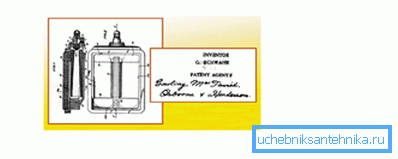
Despite the time elapsed since the invention, the principle of operation of this kind of heater has not changed to this day. Improved only the design and added new ways to heat the heating element.
Device and principle of operation
The main structural elements of the heater are:
- heating element, it will emit IR waves;
- reflector - used to prevent radiation from the heater from spreading around the room, that is, the reflector allows the heater to act in a directional manner. As a rule, the reflector is made of mirror polished steel or aluminum;
- modern devices are equipped with thermostats that allow you to regulate the work of heating;
- Sensors are also included in the design that allow the device to be switched off when overheating.
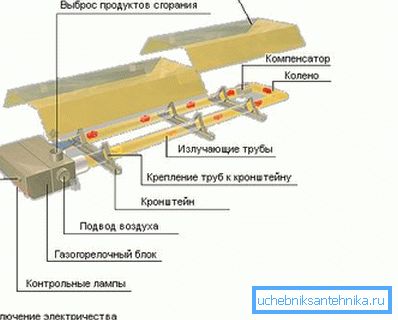
The principle of operation of infrared heating (it is also infrared heating) is fundamentally different from other types of heating housing. If, for example, the radiators of the heating system heat the air in the room, then the infrared heater heats the surface on which invisible rays fall.
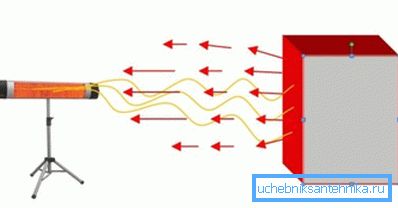
That is why the effect of turning on the heater is noticeable instantly. The air between the radiator and the object almost does not reduce the thermal effect, only slightly dissipates it.
Classification of infrared heaters
The principle of operation of all heaters of this kind is the same, since the main criterion for classification is the method of heating the heating element.
You can select the heating elements of the following types:
- electrical - the principle of operation is that when it is turned on to the network, a current begins to flow through the conductor, it warms up and begins to emit infrared waves;
- industry often use gas or liquid IR heaters.
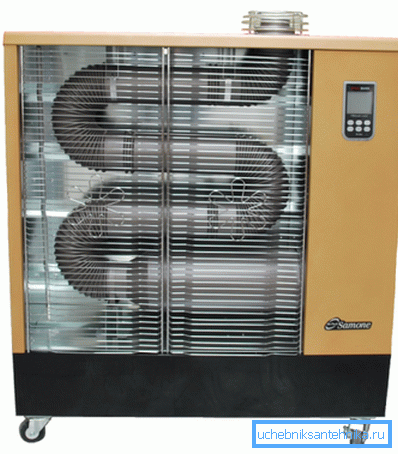
As for the appearance, the options are not so much.
Popular heaters in the form:
- of pictures - in this case, in addition to heating, they are also an element of the decor of the room;
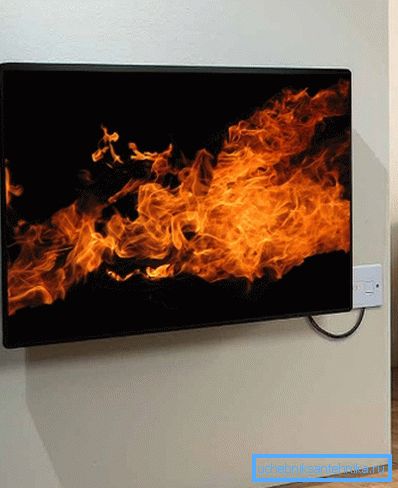
- thin film - with the use of a thin film it is possible to create a warm floor, for this purpose the film is simply placed directly under the floor covering. The dimensions of the conductor are selected in such a way that the floor temperature does not exceed 24-26? C otherwise discomfort will arise when walking.
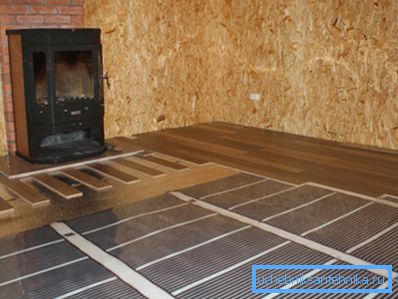
Note! Nothing prevents the film from fastening on the ceiling or on the wall to create a local comfort zone. This solution will look worse than the picture-heater, but the price will be much lower.
- portable devices on an adjustable height support. Such a heater can always be placed next to you.
Attention should be paid to the temperature of the heating thermoelement, depending on this, it can glow or remain not emit visible light.
In this matter, everything depends on the wavelength, if we classify devices according to this parameter, then 3 types can be distinguished:
- shortwave - different "hot temper" emit infrared waves with a length of about 0.7 - 2.5 microns. The heating element may acquire a bright white color during operation. Such powerful devices can also be used in industry, because the temperature of a thermoelement can exceed 800? С;
- with an average wavelength (2.5 - 50 microns). The temperature maximum of the surface is limited to 600? C, while the color ranges from dark to bright red;
- Devices operating in the wavelength range of the order of 50 to 500 μm do not change color during operation. The maximum surface temperature is limited to 300? С.
What do the doctors say
If the choice is made in favor of infrared heating, then you need to think about the effect of radiation on the human body.
It should be borne in mind that:
- a short wave penetrates the body to a sufficiently large depth (of the order of several cm) and affects the internal organs;

- longwave radiation - is delayed by moisture contained in the subcutaneous moisture. The nature of such a phenomenon as heat stroke is explained by just this.
The wavelength range of 7-14 μm can be considered as such, at which the maximum absorption of radiation by the body occurs (a peak is observed around the value of 10 μm). The heating used in medicine uses just such a range of radiation. But it is undesirable for a long time to be in the area of short-wave radiation.
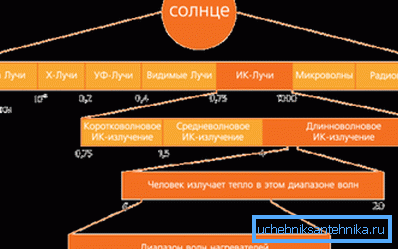
IR heating operating in the long-wavelength range can affect a person with practically no duration limits. Although, of course, much depends on the installation distance of the heater, if you sit close to it all day long, then unpleasant consequences are possible.
In order that nothing threatens health, one should adhere to such stops when organizing infrared heating:
- maximum radiation power should be limited to 350 W / m2;
- if the surface of the thermoelement in the heater exceeds 100? С, then the maximum temperature of the surface of the object falling into the field of its action should be 45? С;
- if the thermoelement does not reach a temperature of 100, then the objects should not be heated to a temperature above 35? С.
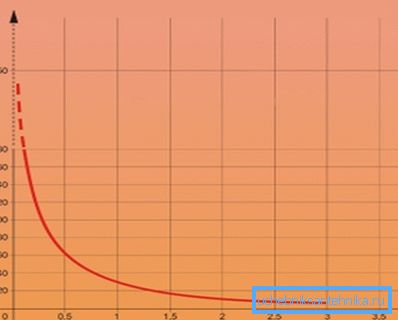
Note! If you allow a long-term effect on the body of infrared radiation of high or even medium intensity, then trouble is guaranteed. Perhaps even the occurrence of burns.
Rules for the installation of infrared heater
In the case of using a portable heater, there will be no special problems with its installation - just place it at the right distance and adjust the height. It is somewhat more difficult to properly install a wall or ceiling heater.
When installing it is necessary to take into account that despite the use of the deflector, the space around the heater is still warming up. Therefore, the base (wall, ceiling) must withstand temperatures of about 80? C without consequences.
Installation instructions for the infrared ceiling heater will look something like this:
- on the ceiling are marked holes for suspensions, holes are drilled;
- then a screw-ring is screwed into the holes;
Note! All elements necessary for mounting the heater are supplied with it.
- then the heater itself is suspended from the chain, its horizontal position is regulated and it is checked whether the minimum distances to the ceiling surface are ensured.
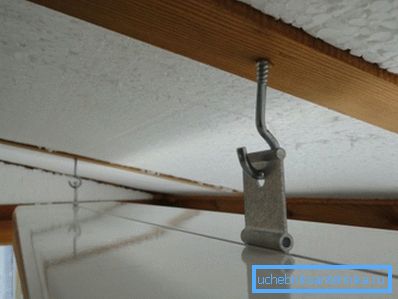
Before connecting it to the network, manufacturers recommend additionally wiping the heating element with ordinary medical alcohol so that nothing interferes with the heat radiation.
Note! The thermostat should be placed at a distance of 1.5-1.8 m from the floor surface. It should not fall within the range of the device.
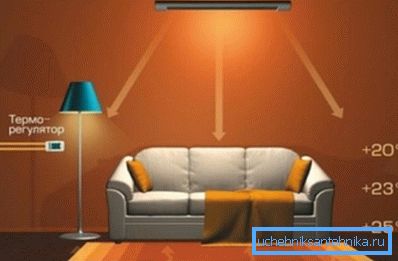
Installing the wall model is even easier - just fix a couple of brackets on the wall and just hang the device on them. The only thing that needs to be controlled is the distance from the back wall of the device to the wall. For ventilation, it is sufficient to provide a gap of the order of 2 to 5 cm, depending on the power of the device.
During installation, special attention is paid to respecting the distances from the device to the surface of enclosing structures and people. These distances are normalized depending on the power of the device. For example, for a ceiling heater of 0.8 kW, the minimum distance to a human head should be about 70 cm, and for a powerful 4 kilowatt - 2.5 meters.
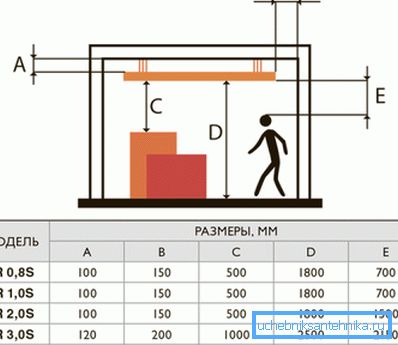
Summarizing
Infrared heating - a promising type of heating housing. Attracts ease of installation and maximum efficiency, because it heats exactly the area in which there is a person. Perhaps in the future this particular type of heating will become dominant, at least in mild climatic conditions.
A short video shows the principle of operation of infrared film heating of a country house.